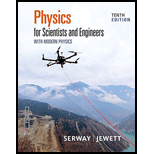
Physics for Scientists and Engineers with Modern Physics
10th Edition
ISBN: 9781337553292
Author: Raymond A. Serway, John W. Jewett
Publisher: Cengage Learning
expand_more
expand_more
format_list_bulleted
Concept explainers
Question
Chapter 44, Problem 8P
(a)
To determine
To show that both baryon number and charge is conserved in the given reactions.
(b)
To determine
The reason for first reaction is observable and the second not.
Expert Solution & Answer
Want to see the full answer?
Check out a sample textbook solution
Students have asked these similar questions
Consider a rubber rod that has been rubbed with fur to give the rod a net negative charge, and a glass rod that has been rubbed with silk to give it a net positive charge. After being charged by contact by the fur and silk...?
a. Both rods have less mass
b. the rubber rod has more mass and the glass rod has less mass
c. both rods have more mass
d. the masses of both rods are unchanged
e. the rubber rod has less mass and the glass rod has mroe mass
8) 9)
10)
11)
12)
13)
14)
15)
Chapter 44 Solutions
Physics for Scientists and Engineers with Modern Physics
Ch. 44.2 - Prob. 44.1QQCh. 44.5 - Prob. 44.3QQCh. 44.5 - Prob. 44.4QQCh. 44.8 - Prob. 44.5QQCh. 44.8 - Prob. 44.6QQCh. 44 - Prob. 1PCh. 44 - Prob. 2PCh. 44 - Prob. 3PCh. 44 - Prob. 4PCh. 44 - Prob. 5P
Ch. 44 - Prob. 6PCh. 44 - Prob. 7PCh. 44 - Prob. 8PCh. 44 - Prob. 9PCh. 44 - Prob. 10PCh. 44 - Prob. 11PCh. 44 - Prob. 12PCh. 44 - Prob. 13PCh. 44 - Prob. 14PCh. 44 - Prob. 15PCh. 44 - Prob. 16PCh. 44 - Prob. 17PCh. 44 - Prob. 18PCh. 44 - Prob. 20PCh. 44 - Prob. 21PCh. 44 - Prob. 22PCh. 44 - Prob. 23PCh. 44 - Prob. 24PCh. 44 - Prob. 25PCh. 44 - Prob. 26PCh. 44 - Prob. 27PCh. 44 - Prob. 29PCh. 44 - Prob. 30PCh. 44 - The various spectral lines observed in the light...Ch. 44 - Prob. 33PCh. 44 - Prob. 34APCh. 44 - Prob. 35APCh. 44 - Prob. 36APCh. 44 - Prob. 37APCh. 44 - Prob. 38APCh. 44 - Prob. 39APCh. 44 - Prob. 40APCh. 44 - An unstable particle, initially at rest, decays...Ch. 44 - Prob. 42APCh. 44 - Prob. 43APCh. 44 - Prob. 44APCh. 44 - Prob. 45APCh. 44 - Prob. 46CPCh. 44 - Prob. 47CPCh. 44 - Prob. 48CPCh. 44 - Prob. 49CP
Knowledge Booster
Learn more about
Need a deep-dive on the concept behind this application? Look no further. Learn more about this topic, physics and related others by exploring similar questions and additional content below.Similar questions
- Mick and Rick are twins born on Earth in the year 2175. Rick grows up to be an Earth-bound robotics technician while Mick becomes an intergalactic astronaut. Mick leaves the Earth on his first space mission in the year 2200 and travels, according to his clock, for 10 years at a speed of 0.75c. Unfortunately, at this point in his journey, the structure of his ship undergoes mechanical breakdown and the ship explodes. How old is Rick when his brother dies?arrow_forwardHi, I have canceled, why did you charge me again?arrow_forwardNo chatgpt pls will upvotearrow_forward
arrow_back_ios
SEE MORE QUESTIONS
arrow_forward_ios
Recommended textbooks for you
 Modern PhysicsPhysicsISBN:9781111794378Author:Raymond A. Serway, Clement J. Moses, Curt A. MoyerPublisher:Cengage Learning
Modern PhysicsPhysicsISBN:9781111794378Author:Raymond A. Serway, Clement J. Moses, Curt A. MoyerPublisher:Cengage Learning College PhysicsPhysicsISBN:9781305952300Author:Raymond A. Serway, Chris VuillePublisher:Cengage Learning
College PhysicsPhysicsISBN:9781305952300Author:Raymond A. Serway, Chris VuillePublisher:Cengage Learning Principles of Physics: A Calculus-Based TextPhysicsISBN:9781133104261Author:Raymond A. Serway, John W. JewettPublisher:Cengage Learning
Principles of Physics: A Calculus-Based TextPhysicsISBN:9781133104261Author:Raymond A. Serway, John W. JewettPublisher:Cengage Learning College PhysicsPhysicsISBN:9781285737027Author:Raymond A. Serway, Chris VuillePublisher:Cengage Learning
College PhysicsPhysicsISBN:9781285737027Author:Raymond A. Serway, Chris VuillePublisher:Cengage Learning University Physics Volume 3PhysicsISBN:9781938168185Author:William Moebs, Jeff SannyPublisher:OpenStax
University Physics Volume 3PhysicsISBN:9781938168185Author:William Moebs, Jeff SannyPublisher:OpenStax Physics for Scientists and Engineers with Modern ...PhysicsISBN:9781337553292Author:Raymond A. Serway, John W. JewettPublisher:Cengage Learning
Physics for Scientists and Engineers with Modern ...PhysicsISBN:9781337553292Author:Raymond A. Serway, John W. JewettPublisher:Cengage Learning

Modern Physics
Physics
ISBN:9781111794378
Author:Raymond A. Serway, Clement J. Moses, Curt A. Moyer
Publisher:Cengage Learning

College Physics
Physics
ISBN:9781305952300
Author:Raymond A. Serway, Chris Vuille
Publisher:Cengage Learning

Principles of Physics: A Calculus-Based Text
Physics
ISBN:9781133104261
Author:Raymond A. Serway, John W. Jewett
Publisher:Cengage Learning

College Physics
Physics
ISBN:9781285737027
Author:Raymond A. Serway, Chris Vuille
Publisher:Cengage Learning

University Physics Volume 3
Physics
ISBN:9781938168185
Author:William Moebs, Jeff Sanny
Publisher:OpenStax

Physics for Scientists and Engineers with Modern ...
Physics
ISBN:9781337553292
Author:Raymond A. Serway, John W. Jewett
Publisher:Cengage Learning